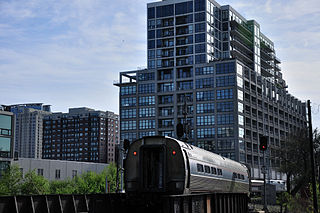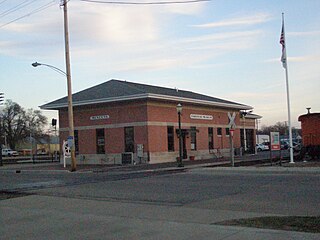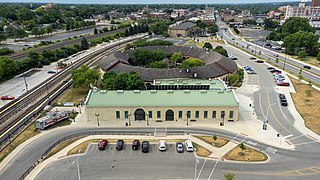
BNSF Railway is the largest freight railroad in the United States. One of six North American Class I railroads, BNSF has 36,000 employees, 33,400 miles (53,800 km) of track in 28 states, and over 8,000 locomotives. It has three transcontinental routes that provide rail connections between the western and eastern United States. BNSF trains traveled over 169 million miles in 2010, more than any other North American railroad.

The Burlington Northern Railroad was a United States–based railroad company formed from a merger of four major U.S. railroads. Burlington Northern operated between 1970 and 1995.

The Galena and Chicago Union Railroad (G&CU) was the first railroad constructed out of Chicago, intended to provide a shipping route between Chicago and the lead mines near Galena, Illinois. The railroad company was chartered on January 16, 1836, but financial difficulties delayed construction until 1848. While the main line never reached Galena, construction to Freeport, Illinois, allowed it to connect with the Illinois Central Railroad, thus providing an indirect route to Galena. A later route went to Clinton, Iowa.

The Chicago, Burlington and Quincy Railroad was a railroad that operated in the Midwestern United States. Commonly referred to as the Burlington Route, the Burlington, CB&Q, or as the Q, it operated extensive trackage in the states of Colorado, Illinois, Iowa, Missouri, Nebraska, Wisconsin, Wyoming, and also in Texas through subsidiaries Colorado and Southern Railway, Fort Worth and Denver Railway, and Burlington-Rock Island Railroad. Its primary connections included Chicago, Minneapolis–Saint Paul, St. Louis, Kansas City, and Denver. Because of this extensive trackage in the midwest and mountain states, the railroad used the advertising slogans "Everywhere West", "Way of the Zephyrs", and "The Way West".

The Illinois Zephyr and Carl Sandburg are a pair of passenger trains operated by Amtrak on a 258-mile (415 km) route between Chicago and Quincy, Illinois. As Illinois Service trains, they are partially funded by the Illinois Department of Transportation. Between Chicago and Galesburg, Illinois, the trains share their route with the California Zephyr and Southwest Chief; the remainder of the route (Galesburg–Quincy) is served exclusively by the Illinois Zephyr/Carl Sandburg.

The BNSF Line is a Metra commuter rail line operated by the BNSF Railway in Chicago and its western suburbs, running from Chicago Union Station to Aurora, Illinois through the Chicago Subdivision. In 2010, the BNSF Line continued to have the highest weekday ridership of the 11 Metra lines. While Metra does not refer to its lines by particular colors, the BNSF line's color on Metra timetables is "Cascade Green," in honor of the Burlington Northern Railroad.

The St. Charles Air Line is a rail line in Chicago, Illinois, partially owned by the BNSF Railway, Union Pacific Railroad (UP), and Canadian National Railway (CN).

The Alton Railroad was the final name of a railroad linking Chicago to Alton, Illinois; St. Louis, Missouri; and Kansas City, Missouri. Its predecessor, the Chicago and Alton Railroad, was purchased by the Baltimore and Ohio Railroad in 1931 and was controlled until 1942 when the Alton was released to the courts. On May 31, 1947, the Alton Railroad was merged into the Gulf, Mobile and Ohio Railroad. Jacob Bunn had been one of the founding reorganizers of the Chicago & Alton Railroad Company during the 1860s.
Chicago, Burlington and Quincy Depot or Chicago, Burlington, and Quincy Station is the name of several railway stations or depots, including:

Mendota station is an Amtrak intercity train station at 783 Main Street, Mendota, Illinois, United States.

Galesburg is an Amtrak intercity train station in Galesburg, Illinois, United States. The station was originally built in 1984, after the razing of the large depot just south of the current site. It is located north of the large BNSF Railway classification yard. Just south the Illinois Zephyr and Carl Sandburg diverge via the Quincy main line which bypasses the yard on the east side. The California Zephyr and the Southwest Chief continue to the southwest side of Galesburg near Knox College.

Macomb station is an Amtrak intercity train station in Macomb, Illinois, United States. There is one daily morning train to Chicago. In the evening, the return train continues on to Quincy, Illinois. The station is a brick structure constructed around 1913 by the Chicago, Burlington and Quincy Railroad as designed by the railroad's architect Walter Theodore Krausch. The city of Macomb leases the station from BNSF Railway to prevent demolition and has done so since 1971.

The Aurora Transportation Center is a station on Metra's BNSF Line in Aurora, Illinois. The station is 37.1 miles (59.7 km) from Union Station, the east end of the line. In Metra's zone-based fare system, Aurora is in zone 4. As of 2018, Aurora is the 13th busiest of Metra's 236 non-downtown stations, with an average of 1,856 weekday boardings. There is a staffed station building. Just north of the station is the Hill Yard, a large coach yard used to store the Metra trains on the BNSF Line. Aurora is a stub-track terminal, which means the Metra tracks end here. Amtrak and BNSF freights use the two tracks east of the station.
The Aurora Subdivision or Aurora Sub is a railway line in Wisconsin and Illinois operated by BNSF Railway. It is part of BNSF's Chicago, Illinois, to Seattle, Washington, Northern Transcon. This segment runs about 262 miles (422 km) from the St. Croix Subdivision in La Crosse, Wisconsin, to the Chicago Subdivision in Aurora, Illinois.

The Chicago Subdivision or Chicago Sub is a railroad line in Illinois that runs about 38 miles (61 km) from Chicago to Aurora and hosts Metra's BNSF Railway Line commuter service. It is operated by BNSF Railway as the easternmost part of the railroad's Northern Transcon to Seattle, Washington. This line is colloquially known as TheRacetrack because it is mostly triple-tracked and supports fairly fast trains. It had been operated by a BNSF ancestor, the Chicago, Burlington and Quincy Railroad, which introduced high-speed Zephyr passenger trains in 1934 and ran many of them along this subdivision from Chicago to points west.

Galesburg Santa Fe Station was a railway station in the west central Illinois town of Galesburg. The station was along the Atchison, Topeka and Santa Fe Railway's main line and served trains such as the Super Chief and El Captain. After Amtrak took over intercity rail in the United States, it was served by trains such as the Lone Star (1971–1979) and the Southwest Chief (1971–1996).
The Cameron connector is a section of track built in 1995–1996 near Cameron, Illinois, that connects the former Burlington Northern Railroad and the former Atchison, Topeka and Santa Fe Railway tracks, both which are now part of the BNSF Railway.
The Chillicothe Subdivision or "Chillicothe Sub" is a railway line running about 229 miles (369 km) from Chicago, Illinois to Fort Madison, Iowa in the United States of America. It is operated by BNSF Railway as part of their Southern Transcon route from Chicago to Los Angeles. The Chillicothe Subdivision is a high volume route connecting three principal yards in Chicago in the east and the Marceline Subdivision in the west which continues to Kansas City.
Galena Junction is a former railroad junction in Jo Daviess County, Illinois, United States. It is located along the BNSF Railway Aurora Subdivision. These tracks were previously built operated by the Chicago, Burlington and Quincy Railroad (CB&Q). A branch line to Galena also joined the main line at Galena Junction. West of the junction, the tracks converged into a single track bridge over the Galena River. The Chicago Great Western Railway's (CGW) main line also diverged at Galena Junction, running parallel with the CB&Q to the southeast and was jointly operated with the CB&Q to the northwest and East Dubuque. The Illinois Central's Iowa Division also joined the tracks west of Galena Junction at "Portage" interlocking. The CB&Q Galena Branch was abandoned in 1964, while the CGW line was abandoned in 1971 by predecessor Chicago and North Western Railway. The former CB&Q branch, along the east side of the Galena River, is now a rail trail.

The Galesburg Yard is a classification yard of the BNSF Railway south of Galesburg in Illinois. It dates back to a goods and classification yard of the Chicago, Burlington and Quincy Railroad (CB&Q), which from 1905 developed into one of the largest classification yards in the USA. At the beginning of the 20th century, Galesburg developed into CB&Q's most important railroad junction, with the main lines from Saint Paul to St. Louis and Kansas City (north-south) and from Chicago to Omaha and Kansas City (east-west) running through it. Nearly all CB&Q's passenger and freight trains passed through Galesburg, where there was also a large railroad depot with several roundhouses.















